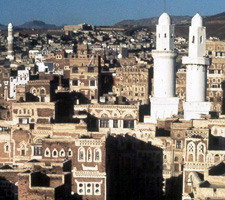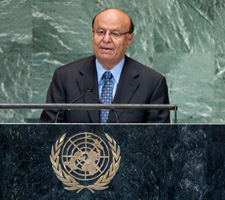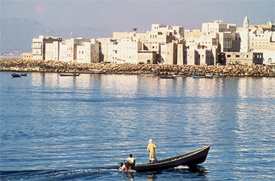
Yemen.
Yemen, the southwest corner and geographical anchor of the Arabian Peninsula, has been torn by strife for years. But unlike Syria, where today’s media attention is focused, Yemen is so remote and so little known to the outside world that its wars and crises are rarely noticed by Western (particularly American) news media and seldom highlighted by foreign affairs gurus. Apart from the al-Qaeda suicide attack on the USS Cole in Yemen’s Aden harbor in the year 2000, few Americans have heard anything substantive about that country from their favorite television news channels, and major newspapers tend to consign its travails to the inside pages.
The difference is that Syria has long been a major player in the Middle East, and its fate is of great interest to many, but so few people know anything about Yemen that it is hard to generate concern for its future.
Yemen? Isn’t that what the Romans called Arabia Felix – Fortunate (and Fertile) Arabia? Wasn’t it the land of the Queen of Sheba?

Old Sana’a is considered by many historians to be one of the oldest, continuously-inhabited cities in the world. Declared a World Heritage City by UNESCO in 1984, Sana’a’s historic section has 103 mosques, 14 hammams (public bath houses), and over 6,000 traditional residences in which Yemenis still live with their families. Photo: Yemen College for Middle Eastern Studies.
Yes, it was those things, but that is about the extent of most Americans’ knowledge of the country. In addition to being an important leg of age-old land and maritime trade routes, Yemen was a formidable ancient sea power at the time of the Phoenicians, and later a medieval center of scholarship and learning. In modern times – up until recent years when the fighting got bad – Yemen was a popular tourist destination for Westerners living and working in the Middle East. Yemen drew tourists looking for a taste of the old Middle East, with its colorful traditional markets, stunning medieval architecture and exotic tribal lifestyles.
For years now, though, this kind of tourism has proven risky. The north of Yemen has been wracked by a revolt of Zaidi Shi’ites called “Houthis” after their late rebel clan leader Hussein Badreddin al-Houthi, killed by government forces in 2004. (His brothers continued the insurgency.) Zaidis, whose faith is an offshoot of mainstream Shi’a belief, make up a sizable chunk of the population in the north. The Houthis agreed to a ceasefire in 2010, but unrest continues.
In the south, Sunni Islamist forces in alliance with Al-Qaeda in the Arabian Peninsula (AQAP) an offshoot of Osama Bin Laden’s al-Qaeda, have been in rebellion against the government. Their expansion led to the declaration of an “Islamic Emirate” in the coastal province of Abyan last year, but Yemeni government forces recaptured its provincial capital, Zinjibar, in June and the Islamist forces have been driven into surrounding mountains. The Islamists of Abyan are called Ansar al-Shari’a, “Partisans of the Shari’a,” and while some say they are not AQAP per se, others claim they are just a “rebranding” of al-Qaeda to gain the support of locals. Whatever the case, the Ansar al-Shari’a provide safe haven to AQAP, and their presence in Abyan has led the United States and Saudi Arabia to furnish quiet support to the Yemeni government in its efforts to subdue the rebels. The exact nature of Saudi and U.S. support is unclear, but U.S. Predator drones equipped with Hellfire missiles are known to have attacked AQAP targets in Yemen – witness the drone attack that killed U.S.-born al-Qaeda operative Anwar al-Awlaki in northern Yemen last year.

Abd Rabbuh Mansur al-Hadi, President of Yemen, addresses the general debate of the sixty-seventh session of the General Assembly. Photo: Jennifer S Altman, United Nations.
These two conflicts, in the North and the South, were exacerbated by and in turn fueled the national Yemeni “revolution” of 2011. This revolution was inspired by the “Arab Spring,” the region-wide popular unrest that began with the self-immolation of a Tunisian street vendor in December 2010 and eventually brought down the leaders of Tunisia, Egypt and Libya (and now threatens Syria’s). The Yemeni revolution ultimately led to the ouster of longtime Yemeni President Ali Abdullah Saleh in February this year and the subsequent election of his vice president, Abd Rabbuh Mansur al-Hadi, as president of the country.
Modern Yemen is a young and fragile state, made up of tribes, clans and factions, with a legacy of division. The country’s North and South have been united only since 1990. Before that, the North was the Yemen Arab Republic, created from a kingdom after a bitter civil war (1962-70) that drew in Egypt and Saudi Arabia, and the South was the People’s Democratic Republic of Yemen (PDRY), a Marxist state that emerged after Great Britain liquidated its Aden Protectorate in 1967. After the two states unified, there was yet another civil war in summer of 1994, this time in the South, as secessionists sought unsuccessfully to recreate an independent Southern Yemen. The secessionist movement has metamorphosed into an ostensibly peaceful effort to free the South from what its adherents regard as exploitation by the North. This organization, called “al-Ḥirāk,” or “the Movement,” is said to be quite popular in southern and eastern areas, and it’s a safe bet that we have not heard the last of it.
Complicating the Yemen problem even further is the country’s dire poverty – it is one of the very poorest nations in the region – exacerbated by its current food crisis, caused in large part by the unrest and violence.

Men in Al-Mahweet in queue to receive World Food Programme (WFP) food assistance. During the dry season from May to October, WFP provides monthly food rations to the poorest households with who have been hit the hardest by rising food prices.Photo: Abeer Etefa, WFP.
The U.N. World Food Program recently reported that 45 percent of Yemen’s population of 23 million is suffering from “food insecurity” – difficulty finding or purchasing adequate food – and the people’s nutritional intake has been described as “poor” or “borderline.” Some 22 percent, or about 5 million people, are classified as “severely food insecure,” a figure that has almost doubled over the past three years. “Yemen is suffering from a serious economic meltdown that marks it as one of the 10 most food-insecure countries with the highest poverty rates in the world,” said Mustafa Nasr, head of Yemen’s non-governmental Studies and Economic Media Center.
Poverty and food shortages can only fuel unrest. Back in May, Saudi Arabia and other Gulf countries, along with Western donors, pledged more than $4 billion in aid to head off a humanitarian disaster and stabilize the Yemeni state, but aid experts at the time said more money and more hands-on involvement was needed.
Saudi Arabia has long had a strategic interest in what happens in Yemen. While we in the West often forget this, the presence of Yemen on the Kingdom’s southern and western borders is constantly on the minds of Saudi foreign policy strategists. Saudi Arabia and Abdul Nasser’s Egypt fought a grim proxy war in Yemen in the 1960s. Today, the concerns involve not Egypt but two very different actors: Iran and al-Qaeda.
Since the fall of Saddam Hussein’s Iraq, the Islamic Republic of Iran has sought to extend its geopolitical influence in and around the Arabian Peninsula, primarily to limit the strategic power of its remaining rival in the area, Saudi Arabia. Some analysts see it in Iran’s interest to encourage the Shi’ite Houthi rebellion in northern Yemen, to distract Saudi Arabia from other regional interests and to keep the Kingdom politically, economically and militarily committed to protecting the southwest corner of the peninsula.
Saudi Arabia, under King Abdullah, has been working to avoid confrontation with Iran, and if possible involve it in regional solutions to problems like Yemen and Syria. In last month’s top-level Islamic conference in Makkah, Abdullah tried to conciliate Iran at the summit’s opening by placing Iranian President Ahmadinejad at his side – a gesture Saudis said was aimed at putting old grievances aside in the quest for a resolution to the Syrian crisis. Notably, King Abdullah has fostered a national dialogue between Sunnis and Shi’ites in his own country and has supported Yemen’s plan for a similar but more expansive peace dialogue to bring together a wide range of religious sects and groups.

Al Mukalla, the main city of wadi Hadramawt, is one of the busiest cities in the country. Photo: Yemen College for Middle Eastern Studies.
The other actor worrying Saudi foreign policy analysts – al-Qaeda – is also of particular concern to the United States, so here the Saudis and Americans can cooperate. This joint concern was recently voiced by Juan Zarate, a former U.S. counterterrorism official and now senior adviser at the Center for Strategic and International Studies: “The United States will continue to intensify its focus on the threats coming from Yemen, while enabling its allies in the region to fight al-Qaeda on the ground.”
He added: “Yemen represents the soft underbelly of the Arabian Gulf, with al-Qaeda rooted in a country with deep economic and resource constraints and ongoing political, demographic, and social upheaval.”
Yemen will not be an easy problem to solve, either for its own leaders or interested and sympathetic governments. Continued unrest in that country will be harmful to Saudi Arabia and the Gulf, and could undermine wider efforts to bring stability and prosperity to the region. All involved parties, national and international, need to exercise great care and patience, and always keep in mind that this particular Middle Eastern tapestry has many different threads, knots and colors that need to be brought together and harmonized before the fabric’s pattern is complete.
